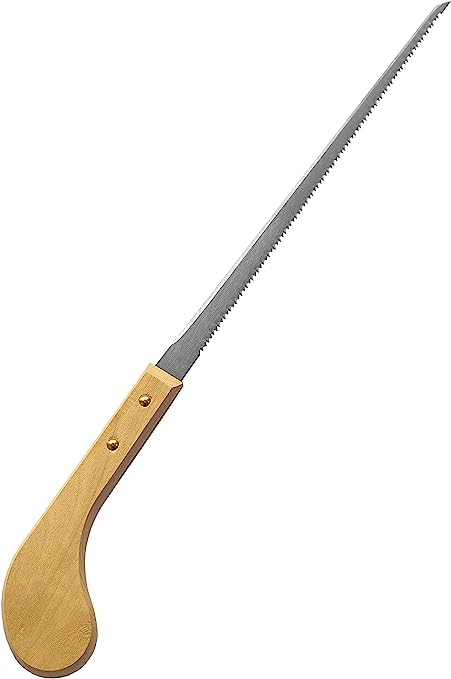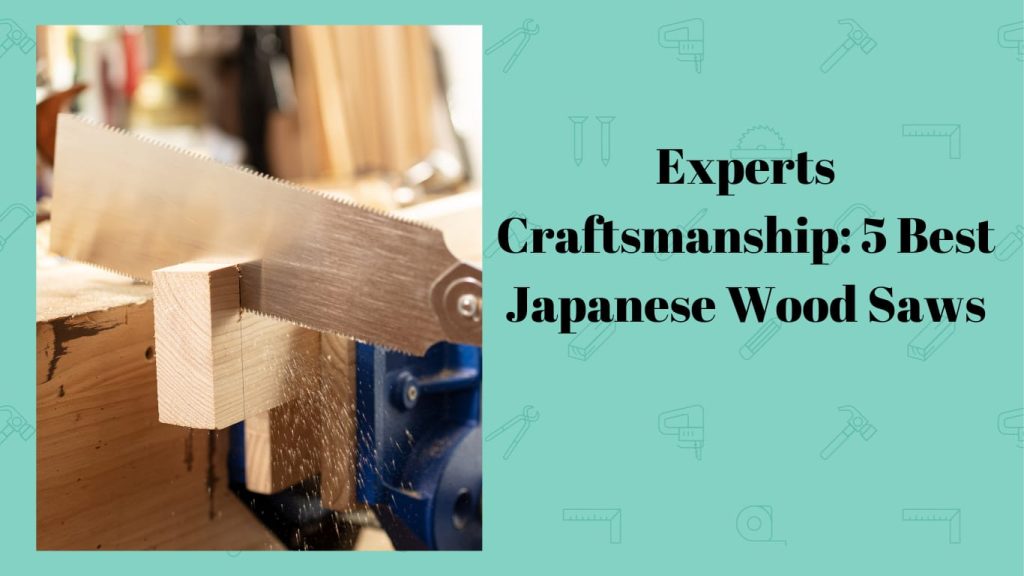The best woodworkers have a Japanese wood saw in their toolbox. Asides from looking impressively fancy, these blades are efficient, versatile, and extremely handy. Owning one unlocks a new level to your woodwork artistry.
Japanese wood saws are cheap – I mean, you can get a kickass Japanese wood saw set for the cost of a mid-price Western saw. With a class set of Japanese woodworking saws, you can even make a traditional Kumiko jig at home. But the real confusion comes when you need to choose the right set – then things get a little tricky.
Read on as we rank the best Japanese wood saw sets in different categories and highlight the best sets for different projects:
My Exclusive List of The Best Japanese Wood Saw
Japanese wood saws aren’t one-size-fits-all tools, and they are as useful as they are unique. But matching your project with the wrong Japanese hand saw for wood can be frustrating.
Here are the six types of Japanese wood saws and the best product in each category:
| Product Image | Product Name | SimpleWoodWorking Rating | What I Liked | What I Didn’t Like | Link |
 | RUITOOL Ryoba Japanese Hand Saw | Best For Beginners | – Its 3-edged design makes it a versatile workshop tool, asides from its primary purpose – Its rip-cut and crosscut teeth are crafted to work on hard and softwood | – The blades on this product aren’t replaceable – You can’t sharpen the blades due to their unique design | Check Price Here |
 | SUIZAN Japanese Kataba Saw | Best for Control | – It is designed to use less power for cleaner – The saw is lightweight, reducing strain as you work – The blade is decently thick, signaling its durability | – The blade wasn’t as sharp as I had hoped – Since it can’t be sharpened, the blade may need regular replacements. | Check Price Here |
 | Denko Sakka Dozuki Pull Saw | Best Budget Friendly | – The saw’s lightweight eases the strain required to pull it – Its sharp teeth make cutting fine edges an absolute breeze – The price range makes it an undeniable steal for its worth | – It is rather small, no bigger than a decent pocket knife – The blade was a little flimsy, looking like a push force could damage it | Check Price Here |
 | Kakuri Azebiki Japanese Wood Saw | Best for Versatility | – Its curved blade head allows you to start fresh cuts in the middle of wood surfaces – The blades design helps carpenters perform detailed cuts while preserving nearby wood – Its ryoba feature increases the saw’s versatility with its rip and crosscut edges | – The blade is thinner than the previously mentioned saw, so extra force may cause it to buckle – The handle seemed rather flimsy when I tested it | Check Price Here |
 | Ranshou Mawashibiki Japanese Keyhole Hand Saw | Best for Curved Cutting | – Its blade is sharpened with ultra-fine diamond for perfect cutting edge – It is versatile and can work in other hole-drilling applications outside of wood – The curved wood handle gives a comfortable and easy grip. | – The ultra-thin edge was rather flimsy and might yield extra force. | Check Price Here |
 | Suizan Japanese Flush Cut Saw | Best for Trimming Pesky Excesses | – The blade works well to delicately remove dowels in tight spaces – It is made with traditional Japanese steel that easily slices through hardwood – For its quality, the purchase is a great value for the price | – The short 5-inch blade might be impractical in some woodwork projects. | Check Price Here |
Best For Beginners: RUITOOL Ryoba Japanese Hand Saw

The Ryoba is the perfect starter kit for a hand-saw newbie. It stands out from the crowd with two sets of teeth on each side – crosscut and rip-cut teeth. With a versatile Ryoba saw in your kit, you can perform all the tasks your Western saw would normally do.
The RUITOOL Japanese Saw is a compact 6” blade designed for flush and finish cuts. I appreciated the double-edged design, which featured a 14TPI edge for cutting softwood and a 17 TPI edge for hardwood. Manufacturers took a step further and added a third edge, designing the blade’s head as a chisel.
What I Liked
- Its 3-edged design makes it a versatile workshop tool, asides from its primary purpose
- Its rip-cut and crosscut teeth are crafted to work on hard and softwood
What I Didn’t Like
- The blades on this product aren’t replaceable
- You can’t sharpen the blades due to their unique design
Best for Control: SUIZAN Japanese Kataba Saw

The kataba differs from the ryoba in appearance and specialty, and unlike the ryoba, kataba saws are conventional-looking pull saws. However, unlike Western pull saws, the Japanese kataba is lighter, faster, and more efficient.
The SUIZAN Japanese Kataba Hand Saw definitely dominated this category with its razor-sharp Japanese steel blade. Suizan saws are handcrafted by Japanese craftsmen, and it showed in the intricate blade and handle design.
What I Liked
- It is designed to use less power for cleaner
- The saw is lightweight, reducing strain as you work
- The blade is decently thick, signaling its durability
What I Didn’t Like
- The blade wasn’t as sharp as I had hoped
- Since it can’t be sharpened, the blade may need regular replacements.
Best Budget Friendly – Denko Sakka Dozuki Pull Saw

Before we get into the unbeatable price range of this saw, Japanese dozuki saws are the premium choice for intricate cuts and precision woodwork. So, they belong in the tour toolbelt if you’re working on delicate cuts or artwork.
Upon opening, the Denko Sakka Dozuki Pull Saw impressed me with its blade edge, promising minimized wood splintering. Next was its ergonomic handle, which fit perfectly with the compact design to give the user enhanced control.
What I Liked
- The saw’s lightweight eases the strain required to pull it
- Its sharp teeth make cutting fine edges an absolute breeze
- The price range makes it an undeniable steal for its worth
What I Didn’t Like
- It is rather small, no bigger than a decent pocket knife
- The blade was a little flimsy, looking like a push force could damage it
Best for Versatility: Kakuri Azebiki Japanese Wood Saw

The Azebiki is a traditional woodworking Japanese saw made for starting cuts where there is no edge. It differs from other pull saws in design and purpose and is perfect for cutting mid-panel grooves, mortises, and sliding dovetails.
Cue – the Kakuri Azebiki Japanese Wood Saw, the saw you’d want to own when working carefully to avoid surrounding wood. Its short, curved blade perfectly fits flat surfaces in hard-to-reach areas. The Japanese pull saw also incorporates ryoba qualities with its double-edge rip and crosscut blades.
What I Liked
- Its curved blade head allows you to start fresh cuts in the middle of wood surfaces
- The blades design helps carpenters perform detailed cuts while preserving nearby wood
- Its ryoba feature increases the saw’s versatility with its rip and crosscut edges
What I Didn’t Like
- The blade is thinner than the previously mentioned saw, so extra force may cause it to buckle
- The handle seemed rather flimsy when I tested it
Best for Curved Cutting: Ranshou Mawashibiki Japanese Keyhole Hand Saw

Mawashibbiki directly translates to “turning cut,” and this blade is the Japanese version of the keyhole saw. Its steel leans toward the tip to form a perfect 5mm keyhole blade for finger joints and mortises.
The Ranshou Japanese Keyhole Hand Saw is made with authentic Japanese steel, which explains the sharp, fine edge. Its thin long blade is perfect for drilling holes, pipes, and woodworking. But you’ll find it in other applications like gardening and cutting plasterboard.
What I Liked
- Its blade is sharpened with ultra-fine diamond for perfect cutting edge
- It is versatile and can work in other hole-drilling applications outside of wood
- The curved wood handle gives a comfortable and easy grip.
What I Didn’t Like
- The ultra-thin edge was rather flimsy and might yield extra force.
Best for Trimming Pesky Excesses- Suizan Japanese Flush Cut Saw

The kugihiki bears a resemblance to the katana, only that it is the Japanese version of a flush-cut saw. It performs other hand-sawing tasks, but the kugihiki excels at trimming dowels and other excess wood from the working surface.
Our category favorite here is the Suizan Japanese Flush Cut Saw. Its durable blade seamlessly cuts through hardwood like ebony, mahogany, maple, and oak. And, due to the saw’s traditional blade and handle, all levels of woodworkers can utilize this kugihiki.
What I Liked
- The blade works well to delicately remove dowels in tight spaces
- It is made with traditional Japanese steel that easily slices through hardwood
- For its quality, the purchase is a great value for the price
What I Didn’t Like
- The short 5-inch blade might be impractical in some woodwork projects.
Our Verdict
After reviewing some of the leading saws in each category, our top Japanese woodworking saw is the Kakuri Azebiki Japanese Wood Saw. This azebiki blade has a place in virtually every toolbox and wears many hats in the workshop, so the carpenter never finds it useless.
My Kakuri Azebiki Japanese Wood Saw sits in our home workshop right now!
In a Nutshell
Starting out with your first Japanese wood saw set is always an interesting experience – a fun new obsession, if you will. They are fashioned in unique ways to serve different purposes in the workshop.
These blades are pull-only saws and might need some getting used to, but that’s only part of the experience. Start slow and master the blade as you work – we’re excited to see your next-level woodwork!
*This post may contain affiliate links. Please see my disclosure to learn more.



